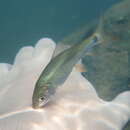Diseases and Parasites
provided by Fishbase
White spot Disease. Parasitic infestations (protozoa, worms, etc.)
Trophic Strategy
provided by Fishbase
Inhabits rivers (Ref. 4832). A diurnal species and usually solitary. Burrows occasionally. Maximum altitude at 500 m and minimum temperature of 14°C. Feeds on detritus, plants and invertebrates (Ref. 11027). Reproductive migration during the monsoon season towards shallow waters of flood plains. Non-spawning adults usually found feeding in littoral zones.
Migration
provided by Fishbase
Potamodromous. Migrating within streams, migratory in rivers, e.g. Saliminus, Moxostoma, Labeo. Migrations should be cyclical and predictable and cover more than 100 km.
Life Cycle
provided by Fishbase
Spawns in middle reaches of rivers, where flood water spreads in more or less limpid shallows over fertile flats, well above tidal reaches; also in reservoirs and bundh-type tanks.
Diseases and Parasites
provided by Fishbase
Sachalinorhynchus Disease. Parasitic infestations (protozoa, worms, etc.)
Diseases and Parasites
provided by Fishbase
Thelohanellus Infection 2. Parasitic infestations (protozoa, worms, etc.)
Diseases and Parasites
provided by Fishbase
Neascus Disease. Parasitic infestations (protozoa, worms, etc.)
Diseases and Parasites
provided by Fishbase
Trichodinosis. Parasitic infestations (protozoa, worms, etc.)
Diseases and Parasites
provided by Fishbase
Ichthyophthirius Disease. Parasitic infestations (protozoa, worms, etc.)
Diseases and Parasites
provided by Fishbase
Sporozoa-infection (Myxobolus sp.). Parasitic infestations (protozoa, worms, etc.)
Diseases and Parasites
provided by Fishbase
Dactylogyrus Gill Flukes Disease. Parasitic infestations (protozoa, worms, etc.)
Diseases and Parasites
provided by Fishbase
Water mold Disease (l.). Fungal diseases
Diseases and Parasites
provided by Fishbase
Fish louse Infestation 1. Parasitic infestations (protozoa, worms, etc.)
Diseases and Parasites
provided by Fishbase
Water mold Disease (e.). Fungal diseases
Diseases and Parasites
provided by Fishbase
Aeromonosis. Bacterial diseases
Diagnostic Description
provided by Fishbase
Dorsal fin with 12-14 1/2 branched rays; lower profile of head conspicuously arched; short dorsal fin with anterior branched rays shorter than head; 12-16 predorsal scales ; snout without lateral lobe (Ref. 43281).
Biology
provided by Fishbase
Adults inhabit rivers (Ref. 4832). A diurnal species and usually solitary. They burrow occasionally. Feed on plants. Spawning season generally coincides with the southwest monsoon. Spawning occurs in flooded rivers. Fecundity varies from 226,000 to 2,794,000 depending upon the length and weight of the fish and weight of the ovary. Widely introduced outside its native range for stocking reservoirs and aquaculture. Utilized fresh (Ref. 9987).
Importance
provided by Fishbase
fisheries: highly commercial; aquaculture: commercial; gamefish: yes

